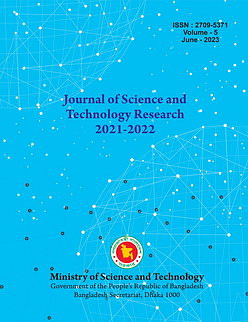Effects of Clinical Mastitis on Reproductive Performances in Dairy Cows
DOI:
https://doi.org/10.3329/jscitr.v5i1.73994Keywords:
Clinical mastitis, reproductive parameters, dairy cowsAbstract
The study was undertaken to study the productive and reproductive performances in clinical mastitis (CM) affected and apparently, healthy dairy crossbred cows and to analyze the effects of mastitis considering age, lactation, and severity of mastitis on reproductive performances in crossbred cows. A survey using a questionnaire was done to record different parameters of the cows during the period November 2021 to March 2022. A total of 58 lactating cows included in this study were divided into two groups named mastitis (n=24) and controlled (n=34). Cows of the mastitis groups were divided into subgroups depending on the age, lactation number and severity of mastitis. Prolactin (PRL), progesterone (P4) and estrogen (E2) levels of cows at the time of AI were analyzed. The results showed that cows of the mastitis group had substantially (P<0.01) higher values for Days to first heat detection after parturition (96.16±6.20), Days to first insemination after parturition (105.00±6.64), Days open (140.58±7.40), and number of services per conception (2.33±0.11). The results also indicated that the greatest values were seen in the cows of Sub-group age >8 for Milking Yield (16.21±2.39 Lt), Days to first heat detection after parturition (109.29±13.57), Days to first insemination following parturition (122.14±15.87), and Days open (165.79±16.70), and in cows of Sub-group 7-8 had for the Days of incidence of mastitis following parturition (51.57±12.73). Considering the number of lactations, we observed the highest values of Milking Yield (16.69±2.20 Lt), Days to first heat detection after parturition (108.75±11.58), Days to first insemination following parturition (120.00±13.96), and Days open (160.63±15.20) in cows of Sub-group lactation number >3 and the highest Days of occurrence of mastitis after parturition in cows of Sub-group lactation number 3. Based on the degree of clinical mastitis, it was found that cows of the severe mastitis sub-group had the greatest Milking Yield (24.80±5.40 Liter) at a significant level (P<0.05). This result indicates an association of severe CM with a high yield of milk. Whereas, there was no significant (P>0.05) variation observed in different parameters in terms of reproductive performances in all sub-groups. In addition, significantly (P<0.01) higher prolactin levels (16.10 ±1.17 ng/ml) and low estrogen levels (13.86±0.57 pg/ml) were present in CM-affected cows. This study could help veterinarians in taking strategies to minimize and control the negative effect of clinical mastitis on the reproduction of dairy cows.
J. of Sci. and Tech. Res. 5(1): 01-07, 2023
227
258
Downloads
Published
How to Cite
Issue
Section
License
Copyright (c) 2023 Mst Iren Akter, Zannatul Maoya, Md Moinul Hasan, Nasrin Sultana Juyena

This work is licensed under a Creative Commons Attribution 4.0 International License.




